Original Article: https://www.austinpetsalive.org/blog/future-of-apa-serving-the-city-of-austin-apa-s-lasting-commitment-to-austin-animals
Sep 02, 2021
This week, we are going back through time to showcase the history of No Kill in Austin and our public-private partnership with the City of Austin.
1998-2001: From the beginning when local attorney Jim Collins created Austin Pets Alive!, it’s mission has been to promote and provide the resources, education and programs needed to eliminate the killing of companion animals in shelters. In order to meet that mission, APA! started as an advocacy organization dedicated to making program and policy changes at the city’s shelter. At this time, the city was euthanizing 85% of the 35,000 animals that entered the shelter on an annual basis. The goal was to make Austin a No Kill City by the year 2000. During this time, the founders coordinated an effective public awareness campaign which led to a doubling of the city shelter’s budget. Additionally, the kill rate was substantially reduced, daily open-adoption hours were introduced, and a volunteer program was created. Despite all of this, No Kill was not reached during this time.

2002-2007: Progress was at a standstill in stopping unnecessary killing largely due to inadequate city resources being allocated to change. The city focused back on trying to “fix the community” rather than fixing the shelter which resulted in very little change in the euthanasia rate.
2008-2011: Still in line with the mission and reinvigorated with new leadership, APA! shifted its strategy to focus on more direct ways to impact the City of Austin shelter’s euthanasia rate, which by 2007 was at 55% with 25,000 animals entering the shelter on an annual basis. We were still an all volunteer organization with less than $10,000 in the bank and no facility, but that didn’t stop us from thinking big. In 2008, we pulled together as many like-minded people as we possibly could and carved out a business plan that would build the infrastructure to address the needs of the up to 14,000 animals who were dying each year at the city shelter.
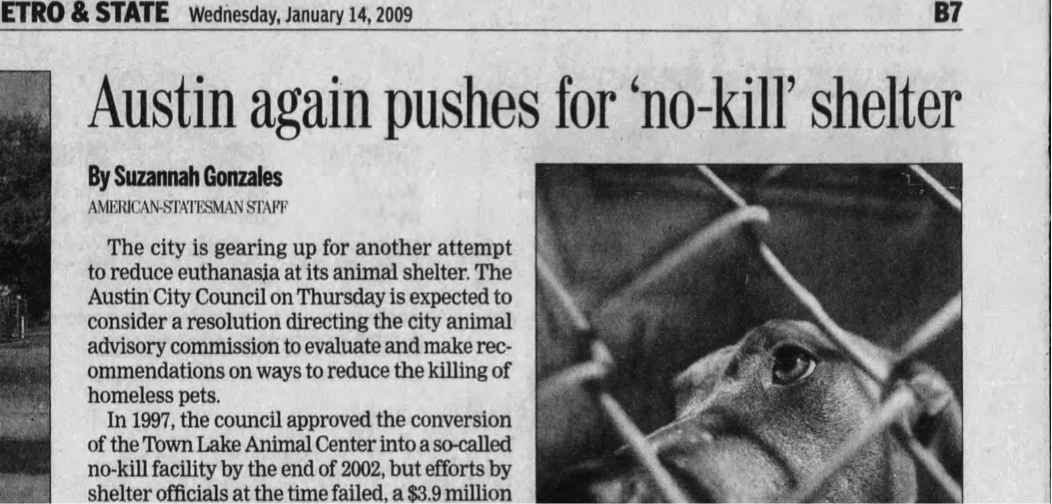
One of the first steps in this new strategy was to intervene in the euthanasia process. As is true today, animals came into the city shelter from many different places for various reasons. After pets were taken in, animals surrendered by their owners moved immediately either to the adoption portion of the shelter, to a rescue group (non APA!), or to a euthanasia list. Stray pets were held for three days before the decision was made to euthanize them or attempt to adopt or transfer them to rescue. Long term Austinites might remember when the Town Lake Animal Center (TLAC) shelter was segregated between animals lucky enough to have survived the last 3 days on the left and those who were too big, dark, scarred, sickly or badly behaved and destined to die on the right behind a locked gate. The public was not allowed to even look at the 75% of campus that was the non-adoption side.
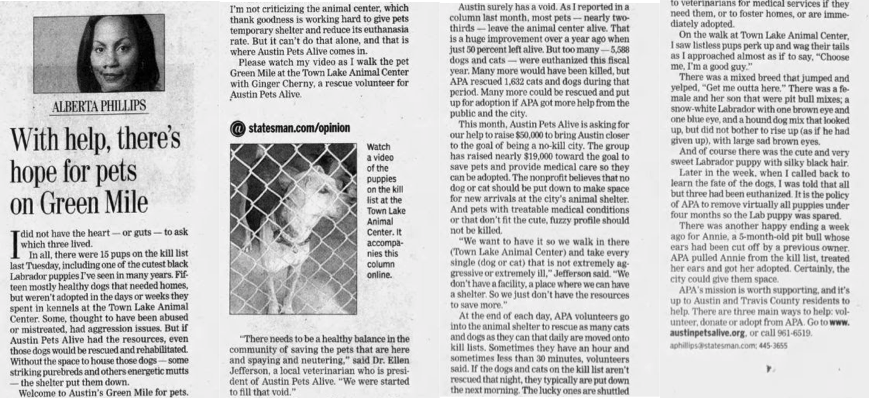
Each day, our team received a list of animals, ranging from 20-100 animals long, that were slated for euthanasia. We were given two hours to try to move those animals to safety by 7 p.m. or they would be dead by 11:30 a.m. the next day.
In those two hours, day after day, 365 days a year, our tough-as-nails volunteer team worked at lightning speed. They posted on Facebook and Craigslist, imploring the community to help by fostering for a short period of time. They texted people they knew that liked labs or poodles to try to find a spare bathroom anywhere to house a pet, who might loosely resemble that breed, until they could make it to an adoption event. Every day, they made an impact on that euthanasia list and cut it down by 10% or as much as 100%. Every week, we could add up each day’s progress to figure out the impact we were making. This eventually translated into a yearly impact metric.
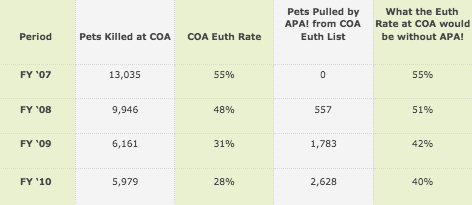
As APA!’s strategy was to intervene in the deaths of the animals at the very last minute, the byproduct was the huge increase in public awareness that these very adoptable animals were dying. The awareness led to public outcry and city council action (very similar to what happened in 1999). That turned out to be an incredibly important part of the puzzle, impacting the euthanasia rate beyond even our direct euthanasia list intervention, and led to Austin becoming No Kill.
By the time our original license agreement to operate TLAC came around in 2011, the community had advocated heavily for change at the city of Austin shelter. The city council passed a 2010 No Kill Implementation Plan, recommended to them by the Austin Animal Advisory Commission after an intense year of public input and strategy sessions. That plan included, most importantly:
- a mandate for the city shelter to reach a 90% live release rate
- a moratorium on killing while any cages were empty (previously this practice left 50 or more kennels open each morning for “possible” intakes)
- a directive for the city shelter to grow a foster program and behavior program
- a directive to use Town Lake Animal Center (about to be vacated for the new location in East Austin) as an adoption center
- an extra $1,000,000 to add to the city shelter budget to help implement these goals
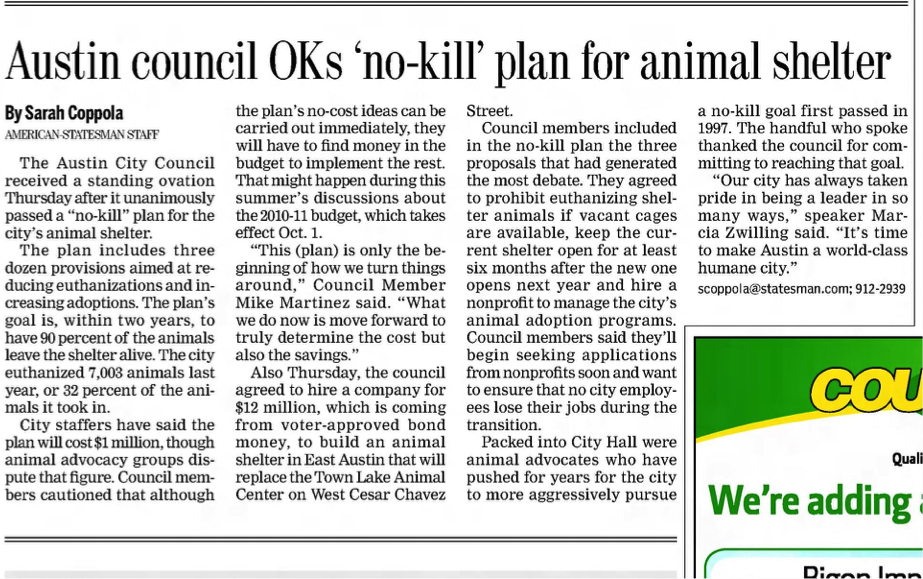
When the city shelter moved from TLAC to east Austin, we had to work tirelessly to gain the ability to use the old shelter. Council Members Martinez and Morrison worked with all parties involved to outline the requirements of that first agreement. Ultimately, APA! agreed to continue taking 3,000 animals from the euthanasia list at the city shelter annually, when the city’s intake was 19,000, the city’s budget was 7 million dollars and they were still euthanizing 2,000 of the pets, even with us pulling 3,000 to safety. The city of Austin and APA! still had a lot of lifesaving work to do to get Austin to No Kill.

2011-2019: A lot has changed in the world of animal sheltering and certainly in the City of Austin during the last decade. The city shelter gained an additional 10 million dollars in their budget and today has a budget of 17 million dollars for an average intake of 18,000. Many of those millions were injected into the city shelter’s medical program despite the fact that APA! had been, since 2011, pulling nearly 100% of the medically challenged animals. Even after millions of tax payer dollars went into medical care for city owned animals at Austin Animal Center (AAC), there were still 1,500+ animals with medical needs listed for euthanasia, down from 3,000+, because the medical practices that AAC employed were more like private practice in their expense and less like the triage APA! used to save lives at a low cost.
In fact, at that stage the animals that were still dying (meaning APA! didn’t have capacity to save them after they were listed on euthanasia list) were almost entirely large breed dogs with and without behavioral challenges. However, almost none of the new AAC funding was directed to help increase fostering or adoptions of those dogs. And almost none of the funding was directed to help pet owners keep their big dogs to prevent intake. There was a brief period of AAC leadership, Tawny Hammond, Lee Ann Shenefiel and Kristen Auerbach, that tried to put more resources into large dogs but they were met with resistance. Because of overall inadequate oversight of the very generous new funding directed by council to “make Austin No Kill”, there continued, and continues, to be a euthanasia list with large breed dogs and medical animals, and there continues to be struggles with large breed dog capacity at AAC. APA! continued to take the “leftover” animals who were listed for euthanasia even though no government funding came to APA! for the care of pets from the city shelter. As AAC management tried to overcome overcrowding, they leaned on APA! to take more and more non-euthanasia list large breed dogs.
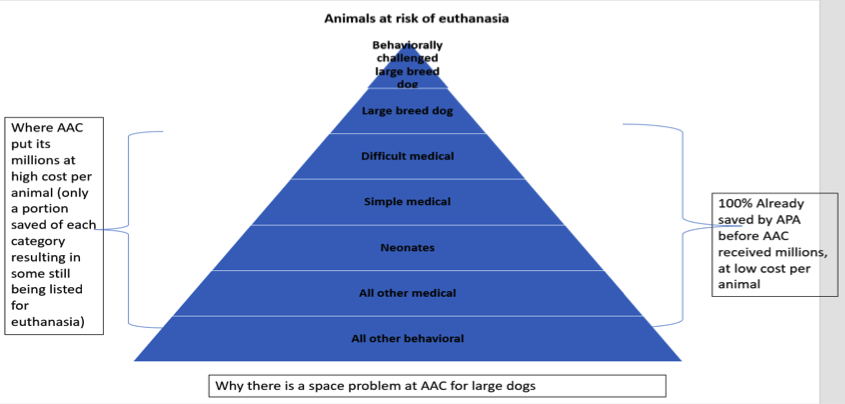
Even with all of these partnership issues, APA! started a behavior program directed at saving the dogs with challenging histories of trauma to prevent their euthanasia at AAC unless there was a severe, demonstrated public safety risk. As per our mission, we didn’t focus on trying to relieve space issues for AAC but of course tried to help.
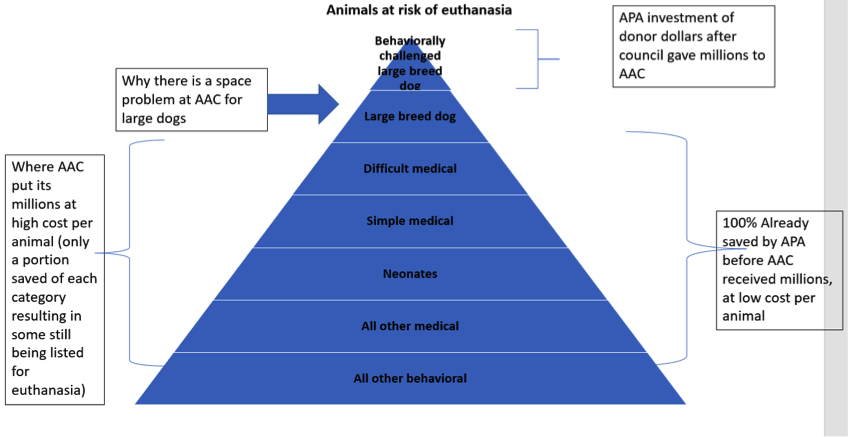
When AAC reached a 95% live release rate, and due to the continual turnover of leadership at AAC which left AAC vulnerable to moving backwards to killing, we focused on building institutional sustainability for No Kill in Austin. No Kill is still very much dependent on the city animal services director’s personal philosophy because there is very little throughout city government to institutionalize it.
Thanks to the ongoing work of Council Member Leslie Pool’s office, a new citywide ordinance to preserve a 95% minimum live release rate and an updated animal code went into effect. In addition, we documented memorandums of understanding (MOU)s to preserve internal practices between AAC and APA! that we hoped would cement No Kill practices in Austin. Austin’s No Kill status was further buoyed by the 2017 Economic Impact Study showing No Kill policy had brought $157M into Austin.
2019-2021: Since 2019, the city has maintained a continual live release rate at or above 95%, in accordance with the ordinance. With the largest budget, per capita and per animal, of any government animal shelter in the nation, AAC has received the financial support to achieve this level of lifesaving. Unfortunately, despite all of this progress, policy changes, and historically high budget, the city has shifted its expectation of maintaining capacity for non-euthanasia list animals to achieve No Kill to APA! with no oversight of existing taxpayer fund usage or financial investment in APA!. This is far outside the scope of the original licensing agreement, signed at a time when 2,000+ animals were still dying and the city’s budget was extremely inadequate for lifesaving. We are proud of our role in making Austin No Kill and advocating for appropriate AAC funding but we have no control or oversight of those funds as a completely private entity. Our fear of losing the use of TLAC has exacerbated that inability to advocate for change in the past.
At the beginning of the COVID-19 pandemic, in early 2020, every shelter in the country emptied their shelters, placing the vast majority of pets in foster homes. This gave the animal welfare industry time to think about the purpose and functions of animal shelters to begin with. APA! pivoted, once again, to focus on keeping human animal families together and launched the Human Animal Support Services (HASS) project. We started HASS because we believe that building the infrastructure to serve community pets and people could dramatically lower the number of pets needing to be institutionalized in the shelter. As APA! and our national arm, American Pets Alive!, worked to implement HASS in most major U.S. cities, we were met within our own city of Austin with some interest but no action to undertake truly solving for why so many animals enter Austin Animal Center every year.
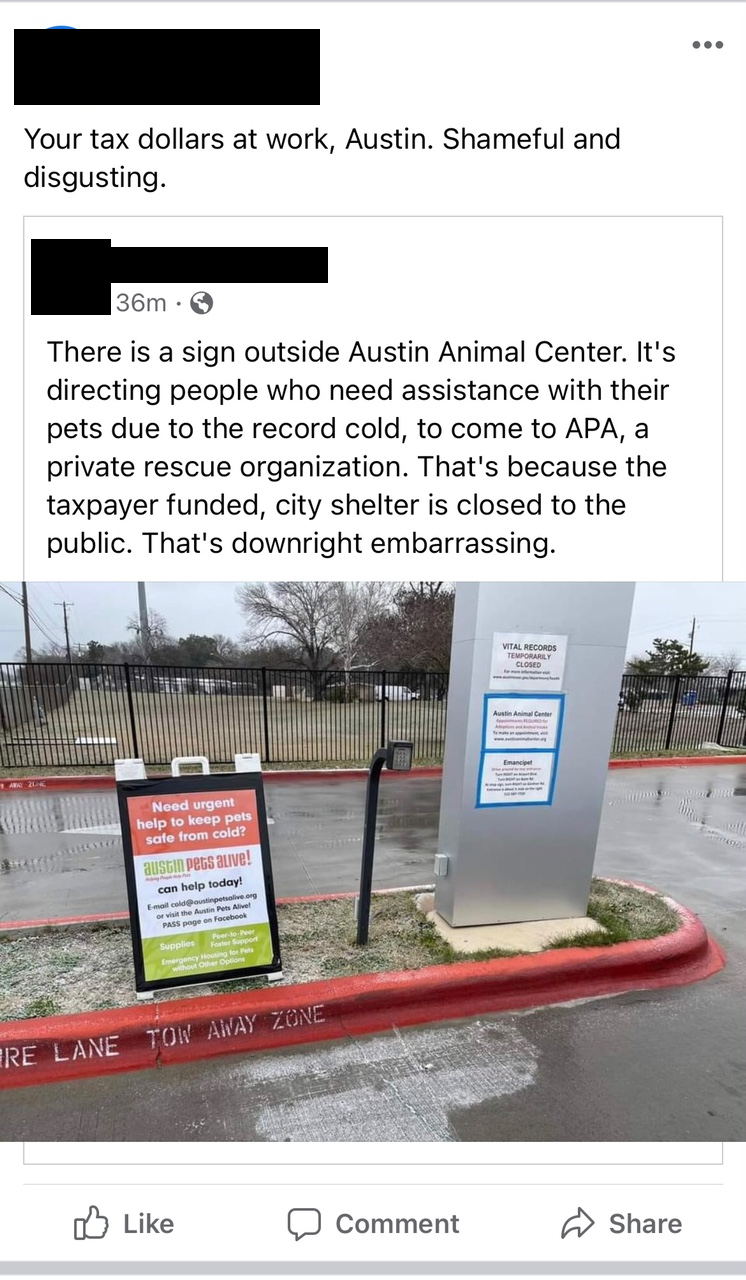
Instead, we, at APA!, have been made painfully aware through multiple crises (the 2021 cold crisis when the city shelter shut down and deferred the public to APA! for help or during the first year of the COVID-19 pandemic when the city shelter just stopped all support to community members who needed much more than a website to navigate options during the human crises they faced), that the city expects the public private partnership to continue, for the next 75 years, as simple, quiet overflow for all of the Austin Animal Center problems.
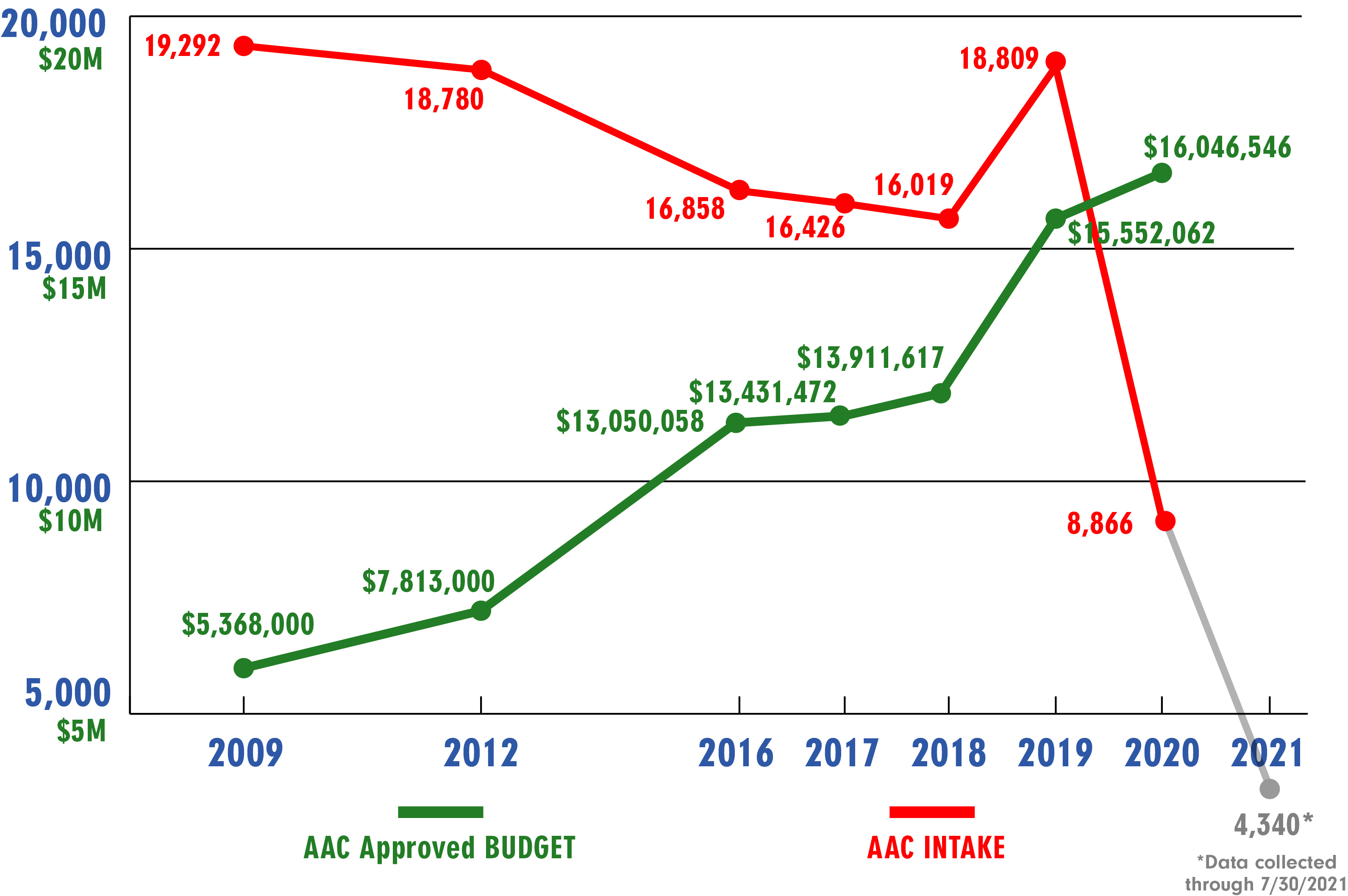
At the same time, the Austin Animal Center is under a high level of scrutiny by the Austin Animal Advisory Commission due to a memo sent by the Austin Animal Center director, claiming that killing of dogs with behavioral histories would need to begin in order to keep capacity at a manageable level, despite a historically low intake of animals. This is unacceptable and we hope the city will use the recommendations from the commission to make lasting change in how the center is managed.
Summer 2021: As of today, the world is rapidly evolving and other cities are passing Austin by as the most progressive for animal welfare. Disheartened by the city’s lack of interest in progressing beyond a No Kill number to build a truly humane community and compounded by the state, and now accepted future, of our facility, we have made the difficult decision to refuse to be the “overflow” for Austin Animal Center any longer or do the rest of the Austin Animal Center’s job for free. We need to go back to a relationship that preserves lifesaving but also drives progress and innovation. Tragically, we are forced to potentially vacate TLAC to gain this but in doing so, we hope Austin will regain its “top” status.
Today: We have let the city know that while we are committed to keeping Austin a No Kill City by taking in animals truly at risk of euthanasia, if there is to be any formal documented agreement with APA! to preserve No Kill status, we will not agree to serve as an overflow facility to animals who are not at risk of euthanasia. And we will not agree to limit the scope of our important and lifesaving work to make the entirety of Texas – and nation – No Kill. It’s still our hope, though now somewhat distant, to have an agreement with the city that allows TLAC to continue as a beacon of hope in this new phase of Austin’s animal history. It is clear that will only happen if the city council directs staff to make it happen.
Soon, we will need your help to advocate for these changes to our contract and to the overall No Kill sustainability plan for Austin. We can’t do this without our supporters now, just as we couldn’t have created this organization without you from the start. I hope this information helps you to understand why so much is happening at once regarding Austin’s No Kill status and why there are no simple decisions for everyone involved.
Thank you,
Ellen Jefferson, DVM
President and CEO
Austin Pets Alive!/American Pets Alive!
Read the previous posts in this series here.
Source: Austin Pets Alive












